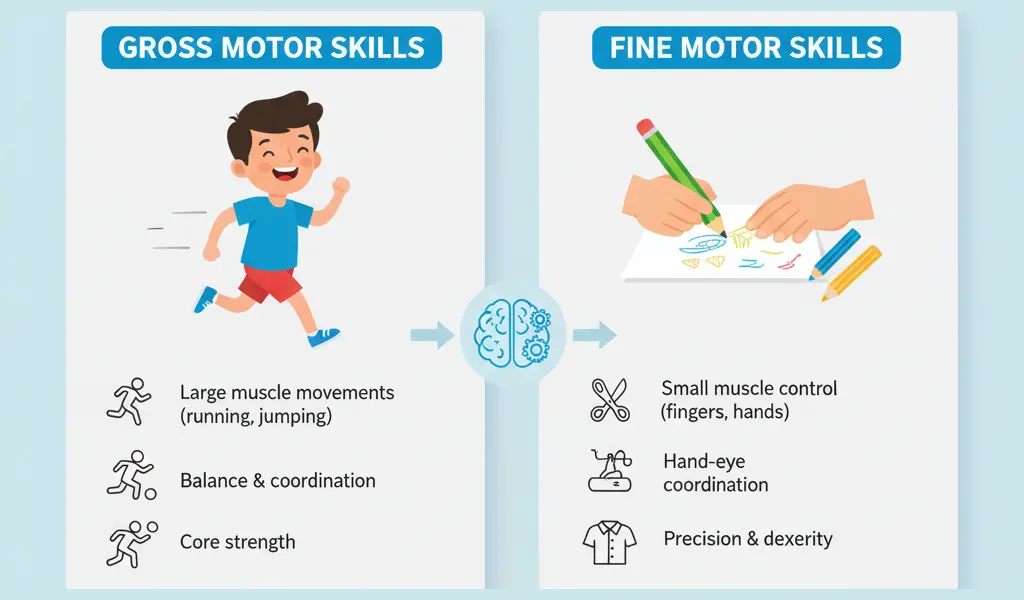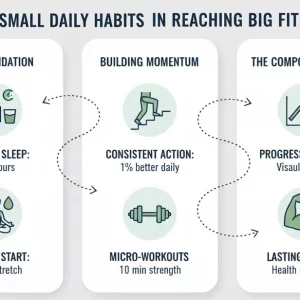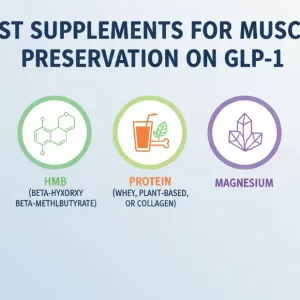Contents
When we think about physical performance, we often imagine strength, speed, or endurance. Yet, behind every squat, sprint, or swing lies a deeper foundation: motor skills. These skills are the building blocks of movement. From a baby’s first steps to an elite athlete’s winning performance, motor skills determine how efficiently we move, adapt, and excel.
In this article, we’ll explore the basics of motor skills, the difference between fine vs. gross motor skills, stages of motor development, and why they matter not just for athletes, but for everyone—from children to older adults.
What Are Motor Skills?
Motor skills are learned movements that involve the coordination of the brain, nervous system, and muscles to produce purposeful action. They are not purely instinctive; they are developed through repetition, practice, and neurological adaptation.
For example:
- A child learning to catch a ball is developing hand-eye coordination (a motor skill).
- A weightlifter improving squat technique is refining gross motor control.
- A pianist mastering delicate finger movements is sharpening fine motor precision.
Motor skills blend cognitive processes (planning the action) and physical execution (muscle activation). This is why they form the basis of all movement—from basic daily activities like walking and eating, to complex athletic performances.
Fine vs. Gross Motor Skills
A central distinction in motor skills is fine vs. gross motor skills.
Gross Motor Skills
Gross motor skills involve large muscle groups and whole-body movements. These skills are essential for balance, strength, coordination, and mobility.
Examples include:
- Walking, running, and jumping
- Throwing a ball
- Performing squats or push-ups
- Swimming strokes
Gross motor skills are critical for athletic performance and functional independence. Without well-developed gross motor coordination, even simple tasks like climbing stairs or maintaining balance become challenging.
Fine Motor Skills
Fine motor skills involve smaller muscle groups—especially in the hands, fingers, and wrists. These skills require precision, dexterity, and control.
Examples include:
- Writing or drawing
- Buttoning a shirt
- Typing on a keyboard
- Controlling grip strength in sports (e.g., tennis, rock climbing)
Fine motor skills may seem less important for athletics, but they are crucial for sports requiring precision—archery, gymnastics, martial arts, and even weightlifting where grip and bar control are essential.
Stages of Motor Development
Motor skills develop across a lifelong continuum, starting in infancy and continuing through adulthood. Understanding these stages helps trainers, coaches, and parents support proper growth and performance.
1. Reflexive Movements (0–1 year)
- Involuntary responses to stimuli (grasp reflex, sucking reflex).
- Foundation for voluntary movement.
2. Rudimentary Movements (0–2 years)
- Basic voluntary control emerges.
- Rolling, crawling, sitting, walking.
3. Fundamental Movement Phase (2–7 years)
- Development of basic skills: running, jumping, throwing, catching.
- Children learn movement patterns through play.
4. Specialized Movement Phase (7–14 years)
- Skills become refined and adapted for sports or activities.
- Transition from “play” to structured training.
5. Lifelong Application (14 years onward)
- Continued refinement through practice and sport-specific training.
- Adults adapt motor skills to personal goals (athletics, fitness, or daily function).
- Later in life, motor skill maintenance is key for independence and fall prevention.
Why Motor Skills Matter
Motor skills are not just for children or athletes—they are essential across the human lifespan. Here’s why they matter:
1. Athletic Performance
- Coordination and efficiency: Athletes with better motor skills use less energy for movements.
- Reaction time: Quick motor responses determine success in competitive environments.
- Skill acquisition: From dribbling a basketball to performing Olympic lifts, all athletic skills stem from motor learning.
2. Daily Function
- Simple activities—tying shoes, driving, carrying groceries—rely on motor skills.
- Strong motor skills improve independence and confidence in everyday life.
3. Injury Prevention
- Poor motor control often leads to movement compensations.
- Proper coordination and stability lower the risk of overuse injuries and falls.
4. Cognitive Health
- Motor skills and cognitive processes are tightly linked.
- Research shows that learning new motor skills enhances brain plasticity, improving memory and problem-solving.
5. Aging and Longevity
- Motor skill training preserves mobility, coordination, and balance in older adults.
- Prevents falls, one of the leading causes of injury in aging populations.
How Motor Skills Are Learned: The Science of Motor Learning
Motor skill acquisition involves both the brain and the body.
Key Elements:
- Neuroplasticity: The brain adapts by creating stronger neural pathways with practice.
- Feedback: External feedback (from coaches or technology) accelerates learning.
- Stages of learning: Cognitive (understanding the task), associative (refining), autonomous (automatic execution).
- Repetition with variation: Repeating a skill under different conditions enhances adaptability.
Athletes and coaches use motor learning principles to design training sessions that improve coordination, efficiency, and adaptability.
Exercises to Improve Motor Skills
Motor skills can always be developed—whether you’re a child, adult, athlete, or older adult.
Gross Motor Skill Exercises
- Agility ladders (footwork, coordination)
- Sprint drills (reaction time, speed)
- Balance board training (stability, proprioception)
- Strength training with free weights (whole-body coordination)
Fine Motor Skill Exercises
- Grip strengtheners (hand coordination, dexterity)
- Ball toss-and-catch drills with small objects
- Finger dexterity exercises (piano, typing, or therapy putty)
- Precision sports practice (archery, darts, table tennis)
For Older Adults
- Tai chi (balance, controlled movement)
- Walking with varied surfaces (coordination)
- Light resistance training (motor recruitment)
- Functional tasks (carrying, reaching, bending)
Motor Skills in Sports
Athletes often distinguish themselves by their mastery of motor skills:
- Basketball: Dribbling requires fine motor control of the fingers and gross motor coordination for agility.
- Soccer: Ball handling, balance, and agility rely on precise motor skills.
- Gymnastics: Combines fine control (grip, balance) with gross motor acrobatics.
- Weightlifting: Perfect timing and coordination of multiple joints is essential.
Even within the same sport, athletes with superior motor control often excel faster and perform more consistently under pressure.
Improving Motor Skills Through Training
For coaches, trainers, or individuals, here are evidence-based tips:
- Prioritize technique over load – Strength without coordination leads to poor motor development.
- Incorporate variability – Practice skills in different contexts (e.g., dribbling on different surfaces).
- Use feedback loops – Video analysis, coach corrections, or wearable technology help refine movements.
- Progress gradually – Move from basic to complex tasks.
- Integrate cognitive challenges – Dual-task training (movement + mental tasks) improves both brain and motor function.
Conclusion
Motor skills are the foundation of all movement—from everyday activities to elite sports performance. Understanding the difference between fine vs. gross motor skills, recognizing their stages of development, and training them strategically can enhance performance, improve health, and promote lifelong independence.
Whether you’re an athlete seeking peak performance, a parent supporting child development, or an older adult aiming to stay active and balanced, motor skills are central to your journey. By investing in movement skills and physical coordination, you’re not just training your body—you’re training your brain, your resilience, and your long-term well-being.
References
- Gallahue, D. L., Ozmun, J. C., & Goodway, J. D. (2012). Understanding Motor Development: Infants, Children, Adolescents, Adults (7th ed.). McGraw-Hill.
- Payne, V. G., & Isaacs, L. D. (2017). Human Motor Development: A Lifespan Approach (9th ed.). Routledge.
- Schmidt, R. A., & Lee, T. D. (2019). Motor Learning and Performance: From Principles to Application (6th ed.). Human Kinetics.
- Haywood, K. M., & Getchell, N. (2020). Life Span Motor Development (7th ed.). Human Kinetics.
- Clark, J. E., & Metcalfe, J. S. (2002). The mountain of motor development: A metaphor. In J. E. Clark & J. H. Humphrey (Eds.), Motor Development: Research and Reviews (Vol. 2, pp. 163–190). NASPE Publications.
- Adolph, K. E., & Robinson, S. R. (2015). The road to walking: What learning to walk tells us about development. In A. Slater & P. C. Quinn (Eds.), Developmental Psychology: Revisiting the Classic Studies (pp. 102–120). SAGE Publications.
- Barnett, L. M., et al. (2009). Childhood motor skill proficiency as a predictor of adolescent physical activity. Journal of Science and Medicine in Sport, 19(3), 267–272.
- Williams, H. G., Pfeiffer, K. A., O’Neill, J. R., Dowda, M., McIver, K. L., Brown, W. H., & Pate, R. R. (2008). Motor skill performance and physical activity in preschool children. Obesity, 16(6), 1421–1426.
- Voelcker-Rehage, C., & Niemann, C. (2013). Structural and functional brain changes related to different types of physical activity across the life span. Neuroscience & Biobehavioral Reviews, 37(9), 2268–2295.
- World Health Organization (2019). Guidelines on Physical Activity, Sedentary Behaviour and Sleep for Children Under 5 Years of Age. Geneva: WHO.



